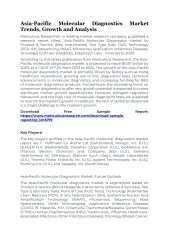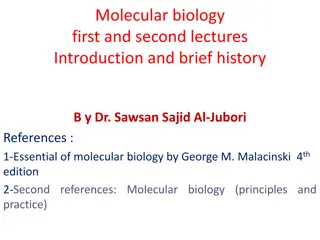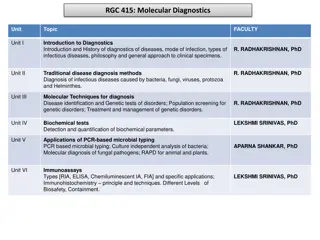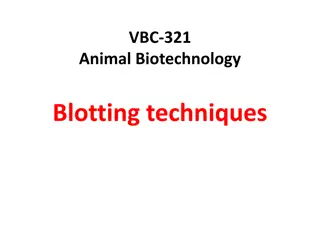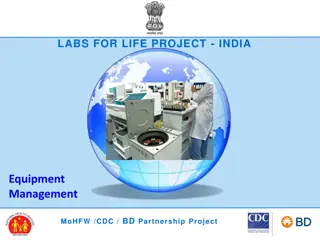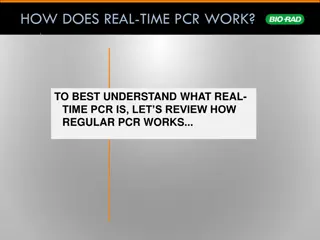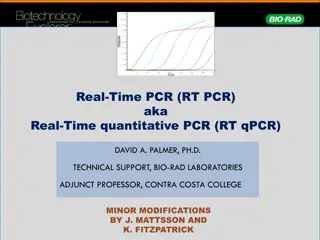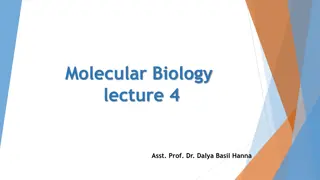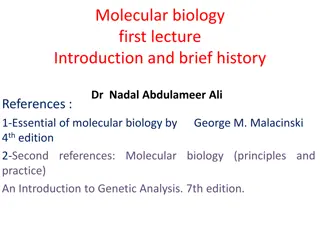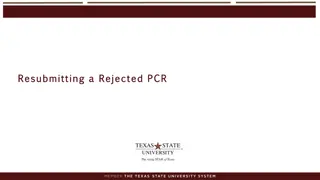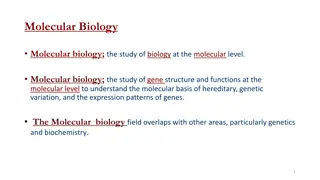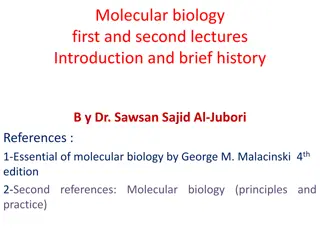PCR and Blot Techniques in Molecular Biology
Polymerase Chain Reaction (PCR) is a crucial technique for amplifying specific DNA segments rapidly and accurately. Developed in 1983, PCR is widely used in various fields such as molecular biology, forensics, evolution, and medical diagnostics. On the other hand, the Blot technique transfers DNA, RNA, and proteins for separation after gel electrophoresis. The steps involved in PCR and the Blot technique play essential roles in molecular biology research and analyses.
Download Presentation

Please find below an Image/Link to download the presentation.
The content on the website is provided AS IS for your information and personal use only. It may not be sold, licensed, or shared on other websites without obtaining consent from the author.If you encounter any issues during the download, it is possible that the publisher has removed the file from their server.
You are allowed to download the files provided on this website for personal or commercial use, subject to the condition that they are used lawfully. All files are the property of their respective owners.
The content on the website is provided AS IS for your information and personal use only. It may not be sold, licensed, or shared on other websites without obtaining consent from the author.
E N D
Presentation Transcript
PCR Polymerase chain reaction ( PCR), a technique used to make numerous copies of a specific segment of DNA quickly and accurately. The polymerase chain reaction enables investigators to obtain the large quantities of DNA that are required for various experiments and procedures in molecular biology, forensic analysis, evolutionary biology, and medical diagnostics. Specific segments of DNA are amplified (copied) in a laboratory using polymerase chain reaction (PCR) techniques PCR was developed in 1983 by Kary B. Mullis, an American biochemist who won the Nobel Prize for Chemistry in 1993 for his invention. The PCR technique is based on the natural processes a cell uses to replicate a new DNA strand. Only a few biological ingredients are needed for PCR. The integral component is the template DNA i.e., the DNA that contains the region to be copied, such as a gene. As little as one DNA molecule can serve as a template.
PCR is a three-step process that is carried out in repeated cycles. The initial step is the denaturation, or separation, of the two strands of the DNA molecule. This is accomplished by heating the starting material to temperatures of about 95 C (203 F). Each strand is a template on which a new strand is built. In the second step the temperature is reduced to about 55 C (131 F) so that the primers can anneal to the template. In the third step the temperature is raised to about 72 C (162 F), and the DNA polymerase begins adding nucleotides onto the ends of the annealed primers. At the end of the cycle, which lasts about five minutes, the temperature is raised and the process begins again. The number of copies doubles after each cycle. Usually 25 to 30 cycles produce a sufficient amount of DNA.
BLOT Blot is a technique in molecular biology which is used for transferring DNA, RNA and proteins onto a carrier, so that they can be separated, often follows use of gel electrophoresis. Three types: Southern-DNA Northern-RNA Western- Protein
Step I: Restriction digest The DNA is fragmentized by using suitable restriction enzyme. RE cuts the DNA at specific site generating fragments The number of fragments of DNA obtained by restriction digest is amplified by PCR Step II: Gel electrophoresis The desired DNA fragments is separated by gel electrophoresis Step III: Denaturation The SDS gel after electrophoresis is then soaked in alkali (NaOH) or acid (HCl) to denature the double stranded DNA fragments. DNA strands get separated Step IV: Blotting The separated strands of DNA is then transferred to positively charged membrane nylon membrane (Nitrocellulose paper) by the process of blotting. Step V: Baking and blocking After the DNA of interest bound on the membrane, it is baked on autoclave to fix in the membrane. The membrane is then treated with casein or Bovine serum albumin (BSA) which saturates all the binding site of membrane Step VI: Hybridization with labelled probes The DNA bound to membrane is then treated with labelled probe The labelled probe contains the complementary sequences to the gene of interest The probe bind with complementary DNA on the membrane since all other non-specific binding site on the membrane has been blocked by BSA or casein. Step VII: Visualization by Autoradiogram The membrane bound DNA labelled with probe can be visualized under autoradiogram which give pattern of bands.
Application of Southern blotting: Southern blotting technique is used to detect DNA in given sample. DNA finger printing is an example of southern blotting. Used for paternity testing, criminal identification, victim identification To isolate and identify desire gene of interest. Used in restriction fragment length polymorphism To identify mutation or gene rearrangement in the sequence of DNA Used in diagnosis of disease caused by genetic defects Used to identify infectious agents
https://www.scribd.com/doc/12896307/Blotti ng-Techniques-PPT



